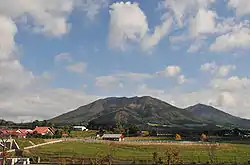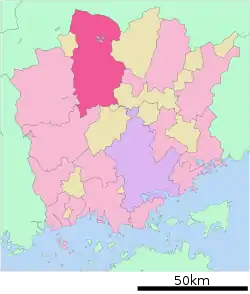Maniwa
Maniwa (真庭市, Maniwa-shi) is a city located in north-central Okayama Prefecture, Japan. Its northernmost border meets that of Tottori Prefecture.
Maniwa
真庭市 | |||||||||||
|---|---|---|---|---|---|---|---|---|---|---|---|
 View of Hiruzen Plateau | |||||||||||
 Flag  Emblem | |||||||||||
 Location of Maniwa in Okayama Prefecture | |||||||||||
 Maniwa Location in Japan | |||||||||||
| Coordinates: 35°4′33″N 133°45′9″E | |||||||||||
| Country | Japan | ||||||||||
| Region | Chūgoku (San'yō) | ||||||||||
| Prefecture | Okayama Prefecture | ||||||||||
| Government | |||||||||||
| • Mayor | Noboru Ota (since April 2013) | ||||||||||
| Area | |||||||||||
| • Total | 828.43 km2 (319.86 sq mi) | ||||||||||
| Population (April 1, 2018) | |||||||||||
| • Total | 44,265 | ||||||||||
| • Density | 53/km2 (140/sq mi) | ||||||||||
| Time zone | UTC+09:00 (JST) | ||||||||||
| City hall address | 2927-2 Kuse, Maniwa-shi, Okayama-ken 719-3292 | ||||||||||
| Website | www | ||||||||||
| |||||||||||
The modern city of Maniwa was established on March 31, 2005, from the merger of the town of Hokubō (from Jōbō District); the towns of Katsuyama, Ochiai, Yubara and Kuse, and the villages of Mikamo, Kawakami, Yatsuka and Chūka (all from Maniwa District), the latter three which make up the area of Hiruzen as a whole.
As of April 1, 2018, Maniwa has an area of 828.43 km², 11.6% of Okayama Prefecture, giving it the largest area of any municipality in the prefecture. It measures roughly 55 km from North to South, and 35 km from East to West. Its population was 44,265, with 17,828 households.[1] The city is known for Mount Hiruzen (1,202 m (3,944 ft)) and the Hiruzen Highlands. Mount Hiruzen (also known as the Hiruzen Sanza, for its 3 sloping peaks) is also the source of the Asahi River (142 kilometres (88 mi)), which flows through much of Okayama Prefecture.[2][3][4][5][6]
Maniwa is also currently known for its Biomass initiatives, and has been given the title of a "Biomass Town", alongside 317 other areas within Japan. It has a biomass electric power plant, which runs using woody biomass in the forms of by-products of the city's lumber industries and household waste. The plant products over 10,000 kW, and can power more than 22,000 of Maniwa's homes, of which it sells some of the energy back to the National Grid. The City Office in Kuse is also fueled by a biomass boiler, and also uses solar panels in an attempt to reduce its carbon footprint.
Geography
Maniwa is located in approximately the center of the Chūgoku Mountains. The mountainous part of the city to the north is dominated by Mount Hiruzen. The Asahi River, a Class 1 river under the Rivers Act of 1964, emerges from Mount Hiruzen in Maniwa, and its upper reaches are located within the town. The river has approximately 146 tributaries. Major tributaries of the Asahi in Maniwa include the Bitchū, Nakazui, Kōchi, Meki, and the Shinjō rivers.[6] The Hiruzen Highlands sit at an elevation of 500-600m above sea-level, and is part of the Daisen-Oki National Park, as of 1 February 1936.
80% of Maniwa's land is covered in forest, 60% of which was planted after World War Two. With thriving lumber industries, Maniwa is investing heavily in biomass and sustainable development of its resources.
With Maniwa being far from any major fault lines, the chance of an earthquake above 7.0 magnitude is less than 1%, small compared to other areas of Japan.
- Lakes
- Lake Yubara
- Dams
- Yubara Dam
- Hokubo Dam
Adjoining municipalities
Climate
Maniwa's climate varies greatly from north to south. The Hiruzen Highlands up north, due to being at a higher elevation, tend to be much cooler in the summer, with heavy snow in the winter, and temperatures often dropping into the negatives. However, further down south in Kuse to Hokubo, snow may fall in the winter but rarely accumulates, but the summers are hotter in comparison to Hiruzen.
Maniwa is also situated far in land, which means that typhoons often do not affect it as badly as seaside towns in Okayama. The mountains throughout the town create a barrier from extremely heavy winds, and so often rain is the biggest side effect of any typhoons passing nearby.
| Kuse (Maniwa) | |||||||||||||
|---|---|---|---|---|---|---|---|---|---|---|---|---|---|
| Month | Jan | Feb | March | April | May | June | July | Aug | Sept | Oct | Nov | Dec | Year |
| Avg Highest Temp °C (°F) | 7.2
(45) |
8.3
(46.9) |
12.5
(54.5) |
19.5
(67.1) |
24.3
(75.7) |
27.5
(81.5) |
30.9
(87.6) |
32.4
(90.3) |
27.7
(81.9) |
21.8
(71.2) |
15.5
(59.9) |
9.8
(49.6) |
19.78
(67.6) |
| Avg Low Temp °C (°F) | −1.8
(28.8) |
−1.6
(29.1) |
0.8
(33.4) |
5.5
(41.9) |
10.7
(51.3) |
16.2
(61.2) |
20.9
(69.6) |
21.6
(70.9) |
17.3
(63.1) |
10.3
(50.5) |
4.6
(40.3) |
0.2
(32.4) |
8.73
(47.71) |
| Rainfall mm (inch) | 52.2
(2.055) |
67.5
(2.657) |
109.0
(4.291) |
116.0
(4.567) |
151.6
(5.969) |
193.6
(7.622) |
248.2
(9.772) |
114.8
(4.52) |
168.6
(6.638) |
91.0
(3.583) |
65.6
(2.583) |
53.4
(2.102) |
1,431.5
(56.359) |
| Avg No Days it rains (≥ 1.0 mm) | 10.2 | 11.1 | 12.2 | 10.3 | 11.2 | 11.7 | 12.9 | 9.2 | 10.6 | 8.0 | 8.4 | 8.9 | 124.7 |
| Avg Sunlight hours p/month | 87.4 | 99.7 | 133.5 | 169.9 | 179.6 | 145.6 | 141.0 | 166.3 | 135.1 | 135.4 | 101.9 | 90.2 | 1,585.6 |
| Source: Japanese Meteorological Agency | |||||||||||||
| Yatsuka (Hiruzen, Maniwa) | |||||||||||||
|---|---|---|---|---|---|---|---|---|---|---|---|---|---|
| Month | Jan | Feb | March | April | May | June | July | Aug | Sept | Oct | Nov | Dec | Year |
| Avg Highest Temp °C (°F) | 4.1
(39.4) |
4.8
(40.6) |
9.1
(48.4) |
16.4
(61.5) |
21.1
(70) |
24.1
(75.4) |
27.6
(81.7) |
28.9
(84) |
24.3
(75.7) |
18.9
(66) |
13.3
(55.9) |
7.5
(45.5) |
16.68
(62.01) |
| Avg Low Temp °C (°F) | −3.9
(25) |
−4.1
(24.6) |
−1.5
(29.3) |
2.8
(37) |
8.2
(46.8) |
13.8
(56.8) |
18.8
(65.8) |
19.4
(66.9) |
14.9
(58.8) |
7.6
(45.7) |
2.3
(36.1) |
−1.7
(28.9) |
6.38
(43.48) |
| Rainfall mm (inch) | 162.3
(6.39) |
156.9
(6.177) |
156.6
(6.165) |
119.5
(4.705) |
143.5
(5.65) |
191.1
(7.524) |
270.1
(10.634) |
144.4
(5.685) |
245.4
(9.661) |
159.8
(6.291) |
142.5
(5.61) |
140.9
(5.547) |
2,033
(80.039) |
| Avg Snowfall (≥ 1.0 mm) | 188
(74) |
179
(70.5) |
69
(27.2) |
0
(0) |
0
(0) |
0
(0) |
0
(0) |
0
(0) |
0
(0) |
0
(0) |
2
(0.8) |
89
(35) |
527
(207.5) |
| Avg No Days it rains (≥ 1.0 mm) | 19.8 | 17.5 | 16.6 | 12.3 | 11.9 | 12.5 | 15.0 | 11.1 | 13.7 | 12.2 | 14.2 | 17.0 | 173.8 |
| Avg Sunlight hours p/month | 53.7 | 68.7 | 112.3 | 157.5 | 174.4 | 139.1 | 135.2 | 155.6 | 111.4 | 113.8 | 82.8 | 66.9 | 1,371.4 |
| Source: Japanese Meteorological Agency | |||||||||||||
Transport
Railways
The main station is Chūgoku-Katsuyama.
Although there is no direct train line to Maniwa from Okayama, travelers can take either the Tsuyama Line to Tsuyama, or the Hakubi Line to Niimi, and transfer to the Kishin Line at either of those stations.
Road
- Expressways:
- Chūgoku Expressway
- Mimasaka-Oiwake Parking Area - Ochiai Junction - Ochiai Interchange - Maniwa Parking Area - Hokubō Junction - Hokubō Interchange
- Okayama Expressway
- Hokubō Junction
- Yonago Expressway
- Ochiai Junction - Kuse Interchange - Ueno Parking Area - Yubara Interchange - Hiruzen-Kōgen Service Area - Hiruzen Interchange
- Chūgoku Expressway
- National highways:
- Main prefectural roads:
- Okayama Prefectural Route 30 (Ochiai-Takebe)
- Okayama Prefectural Route 32 (Niimi-Katsuyama)
- Okayama Prefectural Route 55 (Yubara-Mikamo)
- Okayama Prefectural Route 56 (Yubara-Okutsu)
- Okayama Prefectural Route 58 (Hokubō-Kawakami)
- Okayama Prefectural Route 65 (Kuse-Chūka)
- Okayama Prefectural Route 66 (Ochiai-Kamogawa)
- Okayama Prefectural Route 82 (Kagamino-Kuse)
- Okayama Prefectural Route 84 (Katsuyama-Kurihara)
- Roadside Station
- Hiruzen Plateau (蒜山高原, Hiruzen Kōgen)
- House of Wind (風の家, Kaze no Ie)
- Daigo Village (醍醐の里, Daigo no Sato)
Bus
- There is a direct bus from Okayama City which stops at: Hokubo Mizuta Bus Stop, Maniwa High School Ochiai Campus, Maniwa High School Kuse Campus, Maniwa City Office, Kuse Station, Chugoku-Katsuyama Station[7]
- There is also a local community bus- "Maniwa-kun" which runs daily throughout the city, with most stopping at the City Office.
Sister and Friendship cities
.svg.png.webp) Victor Harbor, Australia - Sister city agreement concluded on May 26, 2000 with the former Hiruzen area. However, since the merger to create Maniwa City occurred, this arrangement is no longer in effect.
Victor Harbor, Australia - Sister city agreement concluded on May 26, 2000 with the former Hiruzen area. However, since the merger to create Maniwa City occurred, this arrangement is no longer in effect. Ruijin, China - Friendship city agreement concluded on January 16, 2001
Ruijin, China - Friendship city agreement concluded on January 16, 2001
Tourism in Maniwa
Due to its lack of infrastructure regarding public transport, most who visit Maniwa come by car.
Hiruzen
80% of tourists visit the Hiruzen Highlands, which are known as one of the more popular resort areas in Western Japan. Due to its high elevation above sea-level, the highlands remain cool in the summer, whilst gains heavy snow in the winter, making it popular with local skiers. Hiruzen also is home to the largest Jersey Cow Farm in Japan, with the "Jersey Land" facilities giving tourists the ability to see the cows up close, milk them, and eat foods made from the Jersey milk. The highlands are also known for their "Cycling Road", a 30 km loop of well-maintained cycling paths, with various rental shops along the route.
Yubara
Yubara Onsen is also a popular resort, with its numerous hot springs (onsen), and close proximity to Hiruzen. Its most well-known onsen, "Sunayu", has been designated one of the representative hot springs of West Japan, and sits at the base of Yubara Dam. It is a rare mixed-sex onsen, and is also free and open 24/7.
Katsuyama
Maniwa is also home to one of Japan's Top 100 waterfalls, Kanba Waterfall. Standing at 110 meters tall and 20 meters wide, it is the largest waterfall in West Japan. It is also home to groups of Japanese monkeys, most often seen during the winter as they come to the valley floor in search of food.
Katsuyama is also an old castle town, which prospered as a stop along the Izumo Kaido, a trade route stretching from Izumo to Kyoto and Osaka. It was also a port, as the river stretches down to Okayama City, and would only take a day or so to reach on the shallow boats they used at the time. Natsume Soseki also stayed here during a war for a few weeks. The town dedicated a 600m stretch of streets to preserve as it would have been in the Edo Period, including the burying of powerlines and reduction of street lights. Currently, the town is known for its Noren curtains, which hang 24/7 outside most homes and shops, and are all made by Yoko Kano, a local artist.
Kuse
Kuse, home to the main city office, is also known for the "Former Senkyo Elementary School." Built in a Western style in 1907, the school is no longer used day-to-day, and has become a tourist attraction. With certain dramas such as "Always" having been filmed here, it is often popular with fans of those dramas. Free to the public, the school also provides Japanese school uniforms you can try at no cost.
Ochiai
Further down south, Ochiai is most famous for the "Daigo-Sakura", a 1000+ year old cherry tree. Sat at the top of a hill deep in the mountains, this cherry blossom tree tends to bloom between mid-late April. A smaller tree, birthed from the original, sits close by on the hilltop. The name "Daigo-Sakura" came from former Emperor Daigo, who, when on his way to exile in the Oki Islands, stopped by this tree and apparently was most impressed by it.
Ochiai is also known for its yōkan, a Japanese sweet made from red beans (anko). In the shape of the narrow boats that used to carry goods down the river to Okayama, and with a light crust of sugar, these sweets are very popular as souvenirs from the city.
Hokubo
At the southernmost tip of Maniwa, Hokubo is most well known for its fireflies in June. One of the best breeding grounds in the prefecture, many tourists visit during this time to see the fireflies during their mating season.
Notable places and events
- The old castle town of Mimasaka-Katsuyama
- Yubara Onsen town
- Kanba Waterfall (Japan's Top 100 Waterfalls)
- Former Senkyō Elementary School Building (Important Cultural Properties)
- Daigo-Sakura (1000+ year old Cherry Blossom tree)
- Hiruzen Area
- Mount Hiruzen
- Shiogama Reisen (Japan's Top 100 Cold Springs)
- Hiruzen Plateau
- Hiruzen Kōgen Center / Joyful Park (Amusement park)
- Hiruzen Jersey Land
- Ski resort
- Hotaru-no-Sato, Hokubo.
- Bitchu-Ana Cave, Hokubo
Festivals
- Hiruzen Omiya Obon Dance Festival (Nationally Designated Important Cultural Property)
- Katsuyama Festival (October 19–20)
- Kuse Festival (October 25–26)
References
- "Official website of Maniwa city" (in Japanese). Japan: Maniwa City. Retrieved 12 April 2017.
- "真庭" [Maniwa]. Dijitaru Daijisen (in Japanese). Tokyo: Shogakukan. 2012. OCLC 56431036. Archived from the original on 2007-08-25. Retrieved 2012-09-04.
- "Asahi-gawa". Dijitaru daijisen (in Japanese). Tokyo: Shogakukan. 2012. Archived from the original on 2007-08-25. Retrieved 2012-05-24.
- "Hiruzen". Nihon Daihyakka Zensho (Nipponika) (in Japanese). Tokyo: Shogakukan. 2012. Archived from the original on 2007-08-25. Retrieved 2012-05-20.
- "真庭" [Maniwa]. Nihon Kokugo Daijiten (in Japanese). Tokyo: Shogakukan. 2012. OCLC 56431036. Archived from the original on 2007-08-25. Retrieved 2012-09-04.
- "真庭" [Maniwa]. Nihon Daihyakka Zensho (Nipponika) (in Japanese). Tokyo: Shogakukan. 2012. OCLC 153301537. Archived from the original on 2007-08-25. Retrieved 2012-09-04.
- 路線バス 高速・勝山線. www.chutetsu-bus.co.jp (in Japanese). Retrieved 2018-08-07.
External links
| Wikimedia Commons has media related to Maniwa, Okayama. |
- Maniwa City official website (in Japanese)



